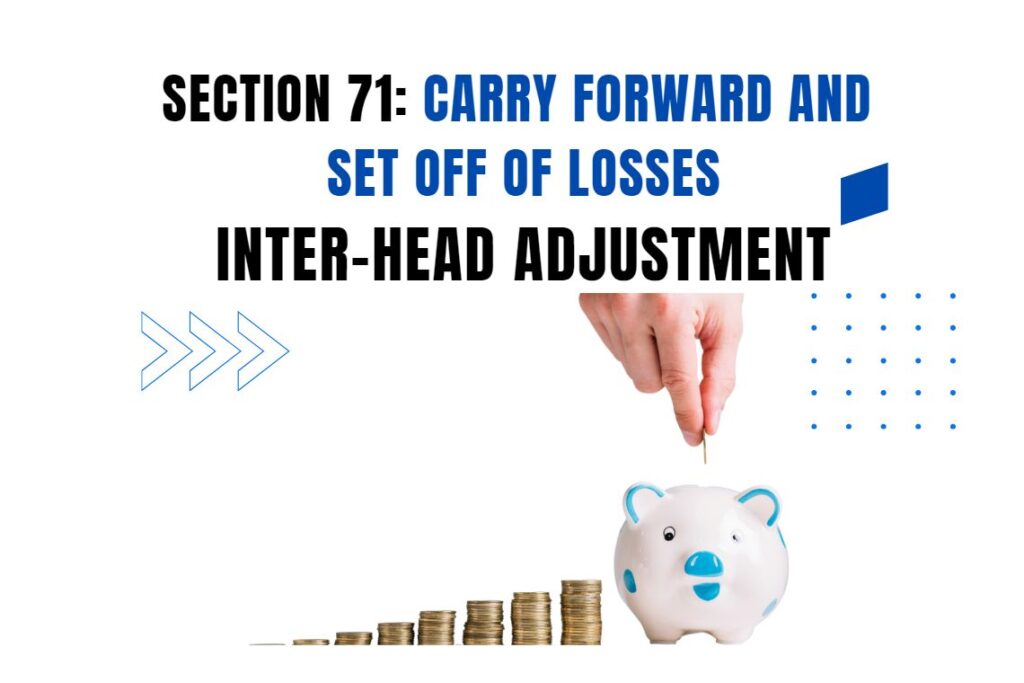1. Introduction to Loss Carry Forward
When losses cannot be fully adjusted in the same financial year, the Income Tax Act allows taxpayers to carry forward these losses to future years for set-off against eligible income. The rules vary based on the type of loss.
2. Key Provisions for Carry Forward & Set Off
A. Business Losses (Non-Speculative) [Section 72]
- Carry Forward Period: 8 assessment years
- Conditions:
- Must file return by due date (usually July 31)
- Business need not continue in future years
- Set Off Rules:
- Can be set off only against business income(any business) in future years
- Exception: Unabsorbed depreciation can be set off against any head except salary
B. Speculative Business Losses [Section 73]
- Carry Forward Period: 4 assessment years
- Conditions:
- Must file return by due date
- Set Off Rules:
- Can only be set off against speculative business profitsin future years
C. House Property Losses [Section 71B]
- Carry Forward Period: 8 assessment years
- Conditions:
- Belated return filing still allowed (unlike business losses)
- Set Off Rules:
- Can only be set off against house property incomein future years
- New Regime: No carry forward allowed
D. Capital Losses [Section 74]
| LOSS TYPE | CARRY FORWARD | SET OFF AGAINST |
| STCL (Short-Term) | 8 years | STCG or LTCG |
| LTCL (Long-Term) | 8 years | Only LTCG |
E. Specified Business Losses (Section 35AD)
- Carry Forward: Unlimited years
- Set Off: Only against income from specified businesses
3. Order of Set Off in Future Years
When multiple losses are carried forward:
- Current year depreciationfirst
- Then unabsorbed business loss
- Then unabsorbed depreciation
- Then other carried forward losses
4. Important Conditions
- Return Filing: Most losses require timely filing (except house property & depreciation)
- Continuity of Business: Not required for normal business losses
- Change in Constitution: Losses can still be carried forward if ownership changes (except proprietary concerns)
5. Practical Examples
Example 1: Business Loss Carry Forward
- AY 2023-24: Business loss ₹5 lakh (return filed on time)
- AY 2024-25: Business profit ₹3 lakh
- Set Off: ₹3 lakh (remaining ₹2 lakh can be carried forward further)
Example 2: Capital Loss Utilization
- AY 2023-24: LTCL ₹2 lakh (return filed)
- AY 2024-25: LTCG ₹1.5 lakh
- Set Off: ₹1.5 lakh (remaining ₹50k continues carry forward)
6. Special Cases
- Startups: Extended period for loss carry forward (Section 79)
- Amalgamation/Demerger: Special rules apply for loss continuity
- Minimum Alternate Tax (MAT): Impacts loss utilization for companies
7. Recent Changes (FY 2023-24)
- New Tax Regime: No carry forward of house property losses
- Startup Benefits: Relaxed conditions for loss carry forward
- Capital Gains: New rules for set-off of losses in certain transactions
8. Key Compliance Points
- Maintain proper documentation of losses
- File returns before due date to preserve carry forward rights
- Track remaining loss amounts each year
- Consider tax regime choice (old vs new) for loss planning
This comprehensive framework allows businesses and individuals to optimize their tax position over multiple years while complying with statutory requirements. Proper planning can significantly reduce tax liabilities through strategic loss utilization.
(A) Compulsory Filing of Loss Returns [Section 80]
1. Introduction to Section 80
Section 80 of the Income Tax Act mandates that losses can only be carried forward if the return is filed within the due date under Section 139(1). This is a crucial compliance requirement for taxpayers seeking to preserve their right to carry forward losses.
2. Key Provisions of Section 80
A. Mandatory Conditions for Loss Carry Forward
- Return must be filed by due date(usually July 31 for individuals)
- Applies to all types of lossesexcept:
- House property losses (can be carried forward even with belated return)
- Unabsorbed depreciation (no filing deadline requirement)
B. Types of Losses Affected
| LOSS TYPE | SECTION | CARRY FORWARD ALLOWED IF RETURN FILED LATE? |
| Business (Non-speculative) | 72 | ❌ No |
| Speculative Business | 73 | ❌ No |
| Capital Losses | 74 | ❌ No |
| House Property | 71B | ✔️ Yes |
| Unabsorbed Depreciation | 32(2) | ✔️ Yes |
3. Consequences of Late Filing
- Losses become ineligiblefor carry forward
- Permanent loss of tax benefitfor that year’s losses
- No recoursethrough revised returns if original return is filed late
4. Exceptions to the Rule
- House Property Losses: Can be carried forward even if return is filed belatedly
- Unabsorbed Depreciation: No time limit for carry forward
- Death of Taxpayer: Legal heirs can file belated return and carry forward losses
5. Practical Implications
Scenario 1: Timely Filing
- FY 2023-24: Business loss ₹8 lakh
- Return filed on July 31, 2024 (due date)
- Result: Can carry forward ₹8 lakh for 8 years
Scenario 2: Late Filing
- FY 2023-24: Business loss ₹8 lakh
- Return filed on August 20, 2024 (belated)
- Result: Cannot carry forward the loss
6. Special Cases
- Startups: Extended due dates may apply under certain conditions
- Audit Cases: Due date is October 31 (extendable to November 30)
- Revised Returns: Can rectify errors but cannot revive lapsed carry forward rights
7. Compliance Checklist
- Mark losses clearlyin ITR (Schedule CFL for carried forward losses)
- Maintain supporting documentsfor all losses claimed
- Verify carry forward amountsin Form 26AS after filing
- Track remaining periodsfor each type of loss






